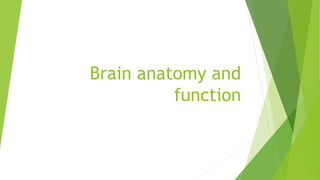
Brain anatomy and function.pptx
- 2. The brain is the body’s control center, it’s held and protected by the skull The cerebrum is the largest part of the brain and is divided into two halves called hemispheres The corpus callosum connects the two hemispheres Each hemispheres is divided into regions called lobes, each lobe has a different function Different parts of the brain are illustrated in the next figure.
- 3. Parts of the brain
- 4. The brain is responsible for many different things including, thinking, decision making, emotion, memory, speech production, as well as muscle control coordination, balance and sensory reception.
- 5. Frontal lobes Frontal lobes are the largest lobes, they are located at the front of the brain They’re responsible for a few things includes, thinking, self-control, making decisions attention, judgement, problem solving and emotions The frontal lobe is also responsible for motor skills and speech production
- 6. Parietal lobe The parietal lobes are just behind the frontal lobe They’re responsible for organizing and interpreting sensory information to the other parts of the brain
- 7. Occipital lobe The occipital lobes are at the back of the brain They’re mainly involved in visual processing including recognition of shapes, colors, patterns, motion Occipital lobes are also involved in reading
- 8. Temporal lobe The temporal lobes are at the level of ears There are responsible for processing auditory information, visual memory, verbal memory and language comprehension They’re also involved in recognizing and understanding reactions and emotions of others
- 9. Cerebellum The cerebellum is located at the back of the brain below the occipital lobes They’re responsible for fine motor skills including fine movement of hands and feet They’re ( cerebellum) is also responsible for balance and coordination and posture
- 10. The brain stem The brain stem is located in front of cerebellum and connects to the spinal cord It’s made up three major parts - Midbrain - Pons - Medulla oblongata
- 11. Midbrain The midbrain is at the top of brainstem It controls eye movement and it also processes the auditory formation
- 12. pons The pons is the largest part of the brainstem it’s just below midbrain It contains nerves that help to connect to different parts of the brain, it also contains some cranial nerves which are involved in facial movement and for transmitting sensory information
- 13. Medulla oblongata The medulla oblongata is the lowest part of the brainstem It controls the functions of the heart and lungs helping to regulate the function things such as breathing, swallowing, sneezing, coughing